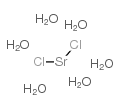Strontium chloride hexahydrate

Strontium chloride hexahydrate structure
|
Common Name | Strontium chloride hexahydrate | ||
|---|---|---|---|---|
| CAS Number | 10025-70-4 | Molecular Weight | 266.61800 | |
| Density | 1,93 g/cm3 | Boiling Point | 1250 °C | |
| Molecular Formula | Cl2H12O6Sr | Melting Point | 115 °C(lit.) | |
| MSDS | Chinese USA | Flash Point | N/A | |
| Symbol |

GHS05 |
Signal Word | Danger | |
|
Analysis of radium-226 in high salinity wastewater from unconventional gas extraction by inductively coupled plasma-mass spectrometry.
Environ. Sci. Technol. 49(5) , 2969-76, (2015) Elevated concentration of naturally occurring radioactive material (NORM) in wastewater generated from Marcellus Shale gas extraction is of great concern due to potential environmental and public health impacts. Development of a rapid and robust method for an... |
|
|
Investigation of the strontium (Sr(II)) adsorption of an alginate microsphere as a low-cost adsorbent for removal and recovery from seawater.
J. Environ. Manage. 165 , 263-70, (2015) In this paper, we investigated alginate microspheres as a low-cost adsorbent for strontium (Sr(II)) removal and recovery from seawater. Alginate microspheres have demonstrated a superior adsorption capacity for Sr(II) ions (≈110 mg/g). A Freundlich isotherm m... |
|
|
Cleavable Molecular Beacon for Hg(2+) Detection Based on Phosphorothioate RNA Modifications.
Anal. Chem. 87 , 6890-5, (2015) Mercury is a highly toxic heavy metal, and detection of Hg(2+) by biosensors has attracted extensive research interest in the past decade. In particular, a number of DNA-based sensing strategies have been developed. Well-known examples include thymine-Hg(2+) ... |
|
|
Design and characterization of a composite material based on Sr(II)-loaded clay nanotubes included within a biopolymer matrix.
J. Colloid. Interface Sci. 448 , 501-7, (2015) This paper reports on the preparation, characterization, and cytotoxicity of a hybrid nanocomposite material made of Sr(II)-loaded Halloysite nanotubes included within a biopolymer (3-polyhydroxybutyrate-co-3-hydroxyvalerate) matrix. The Sr(II)-loaded inorgan... |
|
|
[A case of lung cancer pain relief and safe return home by strontium chloride].
Gan To Kagaku Ryoho. 40(4) , 533-5, (2013) Strontium chloride 89 (89Sr) is used as a systemic radiopharmaceutical therapy for the palliation of pain in patients with metastatic bone cancer. A 64-year-old man had previously undergone an operation to resect his right upper lobe of lung and sixth rib. He... |
|
|
[Effects of strontium chloride activation on the cleavage rate and somatic cell nuclear transfer embryos in mice].
Zhonghua Nan Ke Xue 18(10) , 909-14, (2012) To establish a suitable protocol for activating mouse somatic cell nuclear transfer embryos with strontium chloride (SrCl2).We constructed and identified mouse nuclear transfer (NT) embryos. After nuclear injection, we activated the NT embryos using the follo... |
|
|
[Bone metastases treated with radiopharmaceuticals].
Bull. Cancer 100(11) , 1223-7, (2013) The administration of a radionuclide in unsealed source whose radiation will destroy cells that have selectively accumulated product is called radiometabolic therapy. The management of bone pain is a major problem, particularly in cases of breast or prostate ... |
|
|
The effect of strontium and combinations of strontium and fluoride on the remineralization of artificial caries lesions in vitro.
Quintessence Int. 43(7) , e95-103, (2012) To determine the effect of relatively low strontium concentrations on enamel remineralization and investigate the dose-response effects of strontium and fluoride combinations on the remineralization of artificial caries lesions in vitro.Artificial caries lesi... |
|
|
[Encounter of cancer cells with bone. Treatment of bone metastases from breast cancer].
Clin. Calcium 21(3) , 429-38, (2011) In metastatic breast cancer the most common metastatic site is bone. Skeletal-related events (SREs) as well as bone pain are well-known characteristics of bone metastasis. Activation of osteoclast is the most important mechanism for the progression of bone me... |
|
|
Strontium enhances osteogenic differentiation of mesenchymal stem cells and in vivo bone formation by activating Wnt/catenin signaling.
Stem Cells 29(6) , 981-91, (2011) Strontium ranelate is a newly approved drug that can reduce the risk of vertebral fracture, which is attributed to its dual function in increasing the bone formation and decreasing the bone resorption. Strontium-containing hydroxyapatite was also demonstrated... |